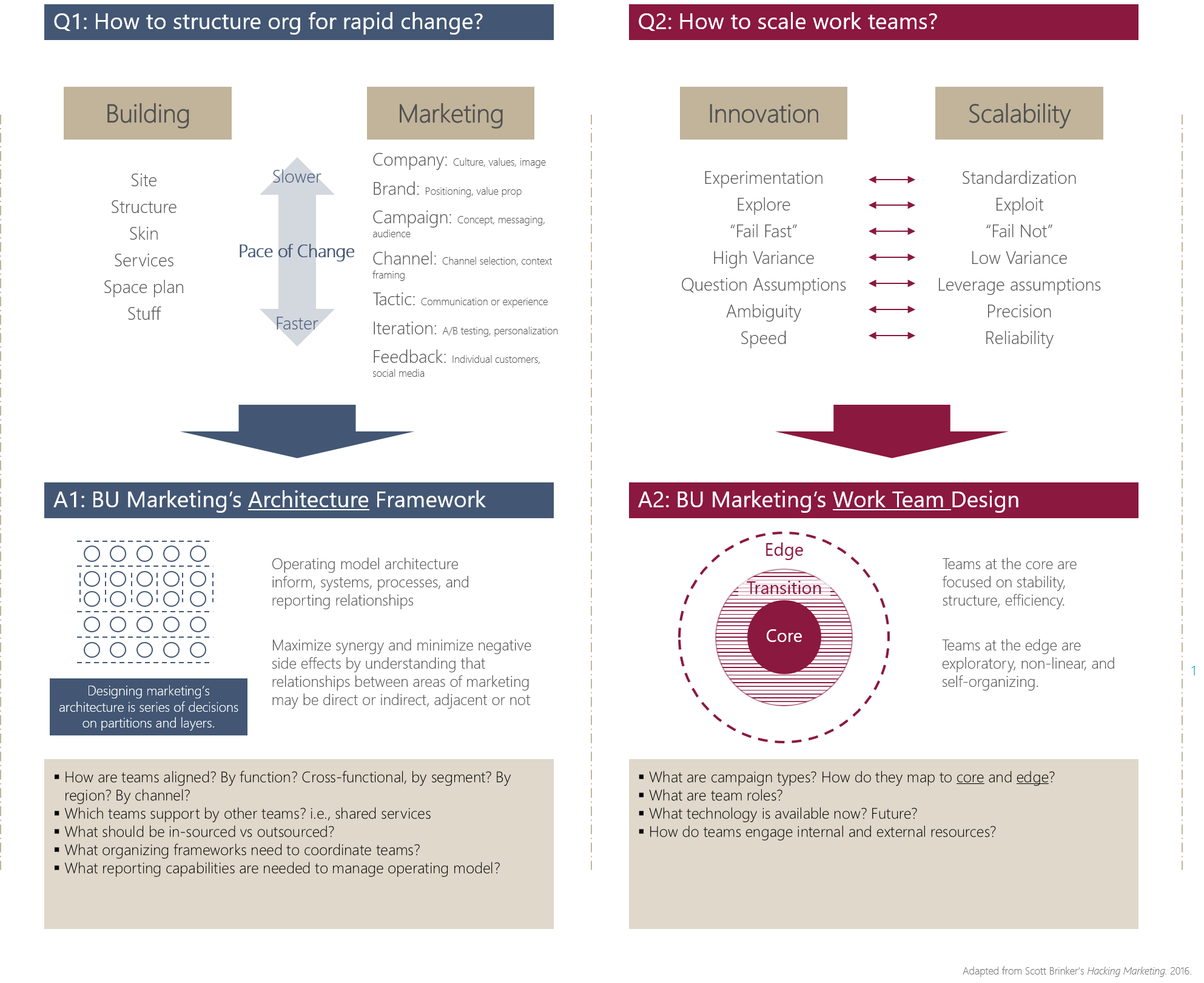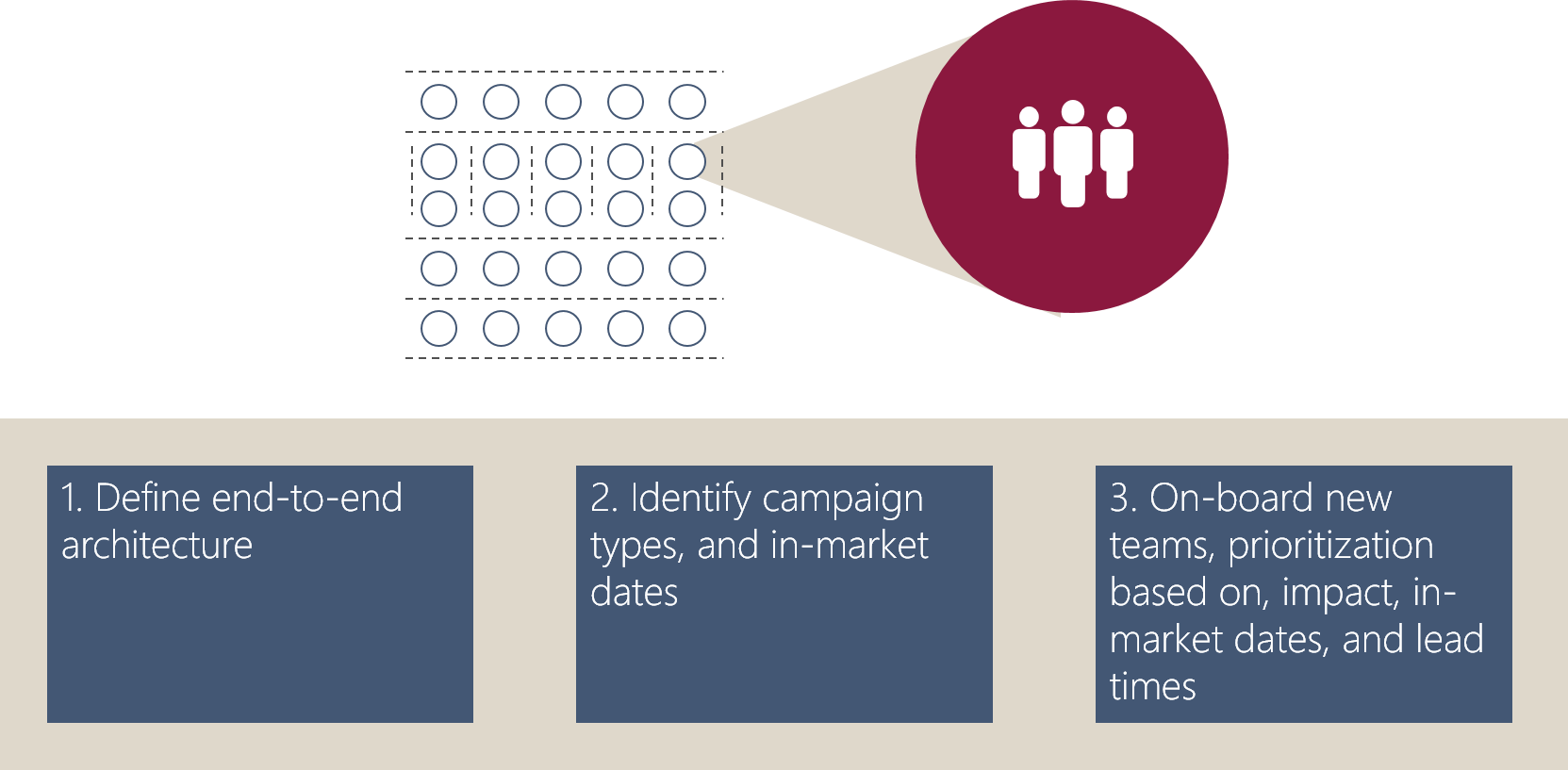
This is the second of 4-part blog series Consumed with 2018 Planning? Activation Needs Equal Attention. The blog series aims to support the timely issues marketing leaders will face in activating their 2018 plans.
I must admit that, intellectually, I am predisposed to top-down change that ensures alignment. But more practicality, we recommend top-down change -- at least initially -- less and less to clients in favor of meeting clients where their operational maturity is at today. They often need incremental change to first establish visible momentum, then they may elevate and expand their approach to change -- with concepts like operating models, blueprinting, etc. -- to tackle the next wave of to-dos that warrant coordinating teams across marketing.
Jim Ewel, one of the authors of the Agile Marketing Manifesto, shared that most organizations need to adopt Agile in small chunks to familiarize the team with the concept and its benefits. Inevitably though they run into the limitations caused by not organizing cross-functional teams. While they've seen some success adopting the use of Kanban boards, daily standups, and in some cases, Scrum, the big benefits come when they change the way they organize and focus on a portfolio of important, customer-centric value streams.
In 2017/18, Agile marketing is establishing itself as THE entry point for bottom up and incremental change. While "the wider" marketing transformation is a top down approach that forces alignment, both work to achieve the same ends: Sustainable improvements allowing for scale and agility in a digital marketing environment. A future state that replaces the hard line between planning and activation that exploits the rich tool set marketing now has available to them today.
Traditionally, marketing organizations are designed to support an overall flow of work that allows them to be oriented to segmented product lines or customer groups. Now that we are thinking of marketing as a digital profession, applying classic technology concepts can liberate how we think about designing the marketing organization and the teams that comprise it in a way that is more sophisticated and nuanced than traditional structural approaches.
We've had several clients apply this "logical design" thinking to some impressive ends. Applying IT concepts to marketing is not necessarily new, but it is concisely described in Brinker's Hacking Marketing (2016). We'll attempt to summarize the key points here:
How to structure for rapid change? Similar to constructing a building, designing marketing's architecture is series of decisions on partitions and layers. The structure should maximize synergies across teams while providing freedom for each team. Done properly, marketing's architecture should answer the questions of what is outsourced? What is retained? What is offered by shared services? Are teams aligned to segments, channels, etc.? What foundational frameworks are necessary to coordinate work across teams?
How to scale work teams? Scale happens by managing the tradeoff with innovation. In doing so, design marketing's internal and external resources to suite the nature of the work: Some teams may be equipped for innovation, and others suited for efficiency. Referencing the graphic below, teams at the core are focused on stability, structure, efficiency. Teams at the edge are exploratory, non-linear, and self-organizing. As you think about your marketing teams and campaigns, are you able to categorize the work in this way?

But how do marketing leader know if the architecture is working? Critical to any top down, bottom up, or agile initiative is consistently performing measurement towards these goals, especially in environments where change initiatives are not managed centrally.
Chris Spears, Chief Marketing Technologist at Atlanta-based Arke, says that, even beyond technology, key metrics need to be established that measure both top-line outcomes and tactical changes. Once you know what capabilities you are changing -- via a measurable metric -- you need to establish the measurement method, determine the baseline, and manage according to them.
Scalability refers to an organization's ability to accommodate rising resource demand gracefully, without a noticeable loss in quality or effectiveness. To measure scalability, we need to calculate how well increasing demand for marketing output (journeys, websites, collateral, etc.) is handled, with metrics such as:
Agility refers to an organizations ability to rapidly adapt in response to changes in the market. A high degree of marketing agility helps a company react successfully to changes in customer preferences, environmental events, the emergence of new competitors, the development of new industry-changing technologies, or respond to different segments or regions differently.
To measure agility, we focus on three key value areas:
All three focus should be equally represented.
Marketing leaders may be overwhelmed by the notion of a cumbersome analysis to reorient their organizations. Their consultants want to spend months and months analyzing and modeling. Their agencies want to jump straight to creation.
We believe there is a better way. New types of service providers and implementation approaches to marketing are emerging with value propositions that fuse together the talent of integrators, consultants and agencies. In 6 to 12 weeks, even the largest and most complicated marketing organizations can formulate an architecture and start to on-board new teams.

In the big button example of an operating model below, we can see the outline of an activation ecosystem composed of an internal agency (IA), external agency (EA) and a Digital Lab. Each member of the ecosystem performs specific types of work: The EA executes new and ongoing programs and campaigns, while the IA focuses on routine materials to "run the business" and maintain collateral. The Digital Lab is yet another area that focuses on building and maintaining prioritized client journeys.
In this operating model, it is not difficult to determine which teams are designed for "core" and "edge" work. Which can be more agile, and which teams should be more waterfall or task-based. Your ecosystem is likely far more complex than this example, with multiple internal and external activation teams, Legal, IT and others in the mix.

With a well-architected activation operating model, the division of labor is established and the road to agile and scalable activation becomes clear. In part 3 of this blog series, we will take a magnifying glass to the marketing operating model and discuss more precisely how members of the activation ecosystem may collaborate or compete, and drive or follow strategy -- depending on the best model for your firm.